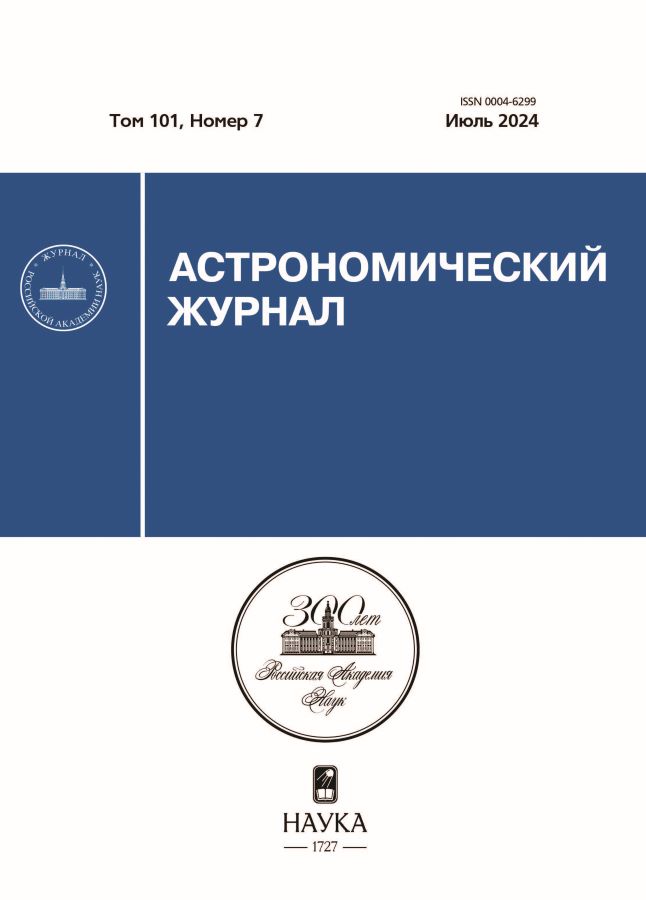Secular evolution and stability of rings around rotationally asymmetrical bodies. Revisiting the problem
- Authors: Kondratyev B.P.1,2,3, Kornoukhov V.S.1,2
-
Affiliations:
- Moscow State University
- Sternberg Astronomical Institute, Moscow State University
- Central (Pulkovo) Astronomical Observatory, Russian Academy of Sciences
- Issue: Vol 101, No 7 (2024)
- Pages: 660-671
- Section: Articles
- URL: https://cardiosomatics.ru/0004-6299/article/view/647692
- DOI: https://doi.org/10.31857/S0004629924070081
- EDN: https://elibrary.ru/IUCHTI
- ID: 647692
Cite item
Abstract
A method has been developed for studying the secular evolution and stabilization of the shape of rings in small celestial bodies that do not have shepherd satellites. A model of a compound ring consisting of two close, generally non-coplanar elliptical Gaussian rings has been constructed. The self-gravitation of the ring is taken into account through the mutual gravitational energy of the boundary rings. The function is presented as a series with an accuracy of up to the 4th power of small eccentricities and mutual inclination of the rings. The secular evolution of a compound ring is described by differential equations in special (collective) variables. For rings without a central body (problem 1), a closed system of 8 differential equations is obtained using the mutual energy function. The evolution of rings in the azimuthally averaged potential of a rotating triaxial body is also studied (problem 2); a second system of eight differential equations is derived for it. In both problems, in addition to the general case, two particular ones are considered: i) the case of coplanar elliptical rings, and ii) the case of circular rings with a tilt. The theory is applied to study the recently discovered ring of the dwarf planet Haumea. It is shown that without taking into account self-gravity, the nodal precession time of the Haumea ring is equal to but taking into account the self-gravity of the ring can reduce this period. It is established that self-gravity does indeed contribute to the preservation of the ring shape without invoking the hypothesis of shepherd satellites. Criteria for the preservation of the ring shape are obtained, which made it possible to estimate the interval for the ratio of the ring mass to the mass of Haumea. Taking into account the optical thickness of the ring, it is shown that the Haumea ring with a mass can consist of ice particles of size m.
Full Text
About the authors
B. P. Kondratyev
Moscow State University; Sternberg Astronomical Institute, Moscow State University; Central (Pulkovo) Astronomical Observatory, Russian Academy of Sciences
Author for correspondence.
Email: work@boris-kondratyev.ru
Faculty of Physics
Russian Federation, Moscow; Moscow; St. PetersburgV. S. Kornoukhov
Moscow State University; Sternberg Astronomical Institute, Moscow State University
Email: work@boris-kondratyev.ru
Faculty of Physics
Russian Federation, Moscow; MoscowReferences
- Н. Н. Горькавый, А. М. Фридман Физика планетных колец (М.: Наука, 1995).
- D. Bérard, B. Sicardy, M. Assafin, F. Braga-Ribas, J. Camargo, M. R. Vieira, R. Duffard, J. L. Ortiz, C. Snodgrass, E. Jehin, et al., American Astronomical Society, DPS meeting 47, 104.02 (2015).
- F. Braga-Ribas, B. Sicardy, J. L. Ortiz, et al., Nature 508, 72 (2014).
- J. L. Ortiz, P. Santos-Sanz, B. Sicardy, G. Benedetti-Rossi, D. Bérard, N. Morales, R. Duffard, F. Braga-Ribas, U. Hopp, C. Ries, et al., Nature 550, 7675, 219 (2017).
- C. L. Pereira, B. Sicardy, B. E. Morgado, et al., Astron. and Astrophys. 673, L4 (2023).
- М. Ф. Субботин Введение в теоретическую астрономию (М.: Наука, 1968).
- B. P. Kondratyev, Sol. Sys. Res. 46, № 5, 352 (2012).
- P. Goldreich and S. Tremaine, Astron. J. 84, 1638 (1979).
- P. Goldreich and S. Tremaine, Annu. Rev. Astron. and Astrophys. 20, 249 (1982).
- N. Borderis, P. Goldreich, S. Tremaine, Astron. J. 88, 1560 (1983).
- J. R. Touma, S. Tremaine, M. V. Kazandjian, Monthly Not. Roy. Astron. Soc. 394, 1085 (2009).
- B. P. Kondratyev, Astrophys. and Space Sci. 361, 169K (2016).
- B. P. Kondratyev, V. S. Kornoukhov, Monthly Not. Roy. Astron. Soc. 478. 3159–3176 (2018).
- P. Kondratyev, V. S. Kornoukhov, Tech. Phys. 64, № 10, 1395 (2019).
- Б. П. Кондратьев, В. С. Корноухов, Астрон. журн. 97, № 5, 408 (2020).
- Г. Н. Дубошин Небесная механика. Основные задачи и методы (М.: Наука, 1975).
- Б. П. Кондратьев, В. С. Корноухов, Астрон. журн. 97, № 10, 866–872 (2020).
Supplementary files














